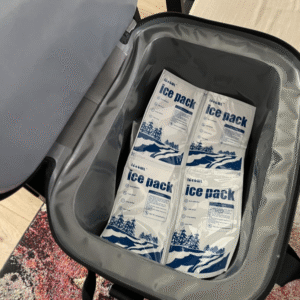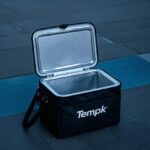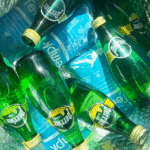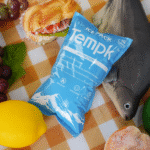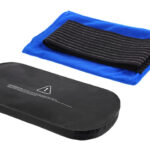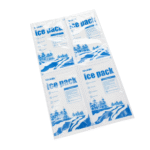Best Dry Ice Bag for a Cooler: What Should You Use?
If you’re packing vaccines, وجبات مجمدة, or a weekend haul, choosing the right dry ice bag for a cooler determines safety, عقد الوقت, and product quality. Dry ice sits at −78.5°C and becomes CO₂ gas, so your bag must insulate, resist punctures, و allow safe venting. This guide compares bag types, shows you how to pack step‑by‑step, and shares a 2‑minute selector to make the right choice fast.
-
أيّ bag type keeps dry ice longest while staying safe (insulated liner, HDPE/LDPE, EPS/VIP options)
-
How to pack a dry ice bag for a cooler in five steps to avoid pressure build‑up
-
How much dry ice you need for 24–72 hours with simple rules of thumb
-
ماذا لا to do (airtight seals, soft coolers without vent paths, direct food contact)
-
2025 cold‑chain الاتجاهات that improve sustainability and monitoring
Which dry ice bag for a cooler keeps cold the longest?
إجابة قصيرة: An insulated, vent‑enabled liner inside a rigid hard cooler delivers the best mix of hold time, متانة, والسلامة. Use a heavy‑duty HDPE/LDPE liner only as an inner sleeve—not as your primary insulator—so CO₂ can escape while the cooler provides structure.
لماذا يعمل: Dry ice sublimates faster when exposed to warm air. A closed‑cell insulated liner slows heat gain, while a rigid cooler protects against puncture. Add a controlled vent path (cracked drain, gasket gap) so CO₂ can exit. This combination is reliable for food and pharma, and it’s simple to repeat for consistent results.
HDPE/LDPE liners vs. insulated dry ice bags—how should you choose?
Go insulated when you need long hold times or frequent lid openings; use HDPE/LDPE liners for clean handling inside a hard cooler when trips are short and budget matters. If you’re shipping multiple days, add a foam board or EPS lid layer above the dry ice to trim sublimation and shield contents from direct contact.
| خيار التبريد (2025) | العزل | مسار تنفيس | ماذا يعني لك |
|---|---|---|---|
| Insulated dry ice liner (closed‑cell) | عالي | Use cooler drain/cracked lid | Best hold time; قابل لإعادة الاستخدام; safer for multi‑day trips |
| Heavy‑duty HDPE/LDPE bag (بطانة سميكة) | Low‑Medium | يفعل لا ختم محكم | Cleaner handling; fine for short hauls inside a hard cooler |
| EPS (الستايروفوم) insert or lid board | عالي (fragile) | Vent via outer cooler | Strong insulation, budget‑friendly; add as a topper |
| Reusable soft insulated tote (تنفيس) | واسطة | Must provide vent gap | مريح; use for short‑to‑mid trips if manufacturer approves dry ice |
نصائح عملية يمكنك التقديم اليوم
-
ما قبل الرغبة في البرودة for 30–60 minutes with sacrificial ice packs.
-
Layer up: dry ice at the bottom → thin cardboard/foam sheet → product → insulation topper.
-
Fill dead air: empty space accelerates sublimation—add towels or frozen gel packs to reduce voids.
حالة العالم الحقيقي: A regional meal‑kit shipper cut spoilage by shifting to insulated liners plus a vented drain plug. The same routes kept meals frozen through 48 hours with fewer re‑ice interventions.
How do you pack a dry ice bag for a cooler safely?
الخطوات الأساسية (follow in order):
-
ارتداء القفازات المعزولة وحماية العين. Treat dry ice like a power tool.
-
Pre‑line the cooler مع insulated dry ice bag or heavy‑duty HDPE/LDPE liner (يفعل لا ختم).
-
Place dry ice at the bottom. Use blocks/pellets wrapped in kraft paper to limit direct contact.
-
Add a separator layer (cardboard or foam sheet), then load product. Finish with an insulation topper.
-
Create a vent path. Crack the drain plug or lid latch slightly so CO₂ can escape. Never use airtight seals.
What about a soft cooler?
If the soft cooler is محكم, don’t pair it with dry ice. Pressure can build. If the soft cooler is manufacturer‑approved for dry ice and you can create a controlled vent gap, it’s fine for short runs. When in doubt, use a rigid hard cooler with a known vent path.
كم ثمن dry ice bag for a cooler do you really need?
Quick‑start rule of thumb (conservative):
-
24 ساعات: ~10–20 lb (4.5-9 كجم) for a ~40‑qt hard cooler at room temperature
-
48-72 ساعة: Scale linearly, then add 20–30% if you’ll open the lid often or run in hot weather
-
Short local runs: A few pounds in an insulated liner may suffice if the load is already frozen
These numbers vary by cooler build, درجة الحرارة المحيطة, كتلة المنتج, and lid‑open frequency. Start conservative, then optimize after one test run with a probe logger.
2‑minute selector (copy‑paste mini‑tool)
What should you لا do with a dry ice bag for a cooler?
-
Do not seal dry ice in an airtight bag, jar, or cooler. Gas needs a way out.
-
Do not use direct contact between dry ice and delicate foods—add a separator sheet.
-
Do not pack in glass or thin brittle plastics.
-
Do not use unapproved soft coolers with airtight zippers.
-
Do not transport in unventilated spaces. Crack windows; avoid confined trunks.
2025 developments and trends for your dry ice bag for a cooler
ما الجديد هذا العام: Reusable insulated shippers are growing fast as brands tackle waste and cost. ISO 23412 keeps shaping last‑mile processes for temperature‑controlled parcels. More operators add أجهزة الاستشعار الذكية for temperature/CO₂ monitoring. Expect broader adoption of recyclable liners and EPS‑light designs that still deliver multi‑day performance.
What’s changing at a glance
-
الأنظمة القابلة لإعادة الاستخدام ترتفع: Lower total cost over repeated lanes; fewer disposables.
-
Sensor‑enabled trips: Low‑cost loggers and CO₂ monitors reduce surprises in transit.
-
Design for recycling: Mono‑material liners and simpler separates boost recovery rates.
نظرة السوق: Analysts project the cold‑chain packaging market to expand through the decade, مع reusable solutions and smart packaging leading growth as e‑grocery and biologics volumes climb.
التعليمات
Can I use a zip‑seal plastic bag as my primary dry ice bag for a cooler?
لا. Zip‑seal bags can trap gas and burst. Use an unsealed HDPE/LDPE liner داخل a rigid cooler and maintain a vent path.
Can I put dry ice in a soft cooler?
Only if the manufacturer explicitly allows dry ice و you can vent it. Airtight soft coolers can build dangerous pressure.
Where should the dry ice sit in the cooler?
At the bottom, then a thin separator sheet, then your product. Add an insulation topper to slow warm air.
How do I dispose of leftover dry ice safely?
Let it sublimate in a well‑ventilated outdoor area away from kids and pets. Never down a sink or toilet.
What gloves should I use?
Insulated or cryogenic‑rated gloves. Avoid cotton alone; it can freeze and stick to skin.
ملخص & الخطوات التالية
الوجبات الرئيسية: استخدم insulated, vent‑enabled liner inside a hard cooler as your primary dry ice bag for a cooler. Keep a مسار تنفيس, يضيف separator sheets, و fill dead air لإبطاء التسامي. Start with conservative dry ice amounts, log one trial, then tune.
Do this next:
-
Choose an insulated liner + rigid cooler combo.
-
Pack using the 5‑step method and crack the drain for venting.
-
Test once with a probe logger, then apply the estimator above to right‑size your dry ice for future runs.
حول Tempk
We build practical cold‑chain content and tools for teams shipping temperature‑sensitive goods. Our recommendations focus on repeatability و أمان—from insulated liners to pack‑outs you can train in minutes. We prioritize reusable, vent‑safe solutions that balance cost with product protection.
بحاجة الى مساعدة? Book a 15‑minute pack‑out review with our team.






